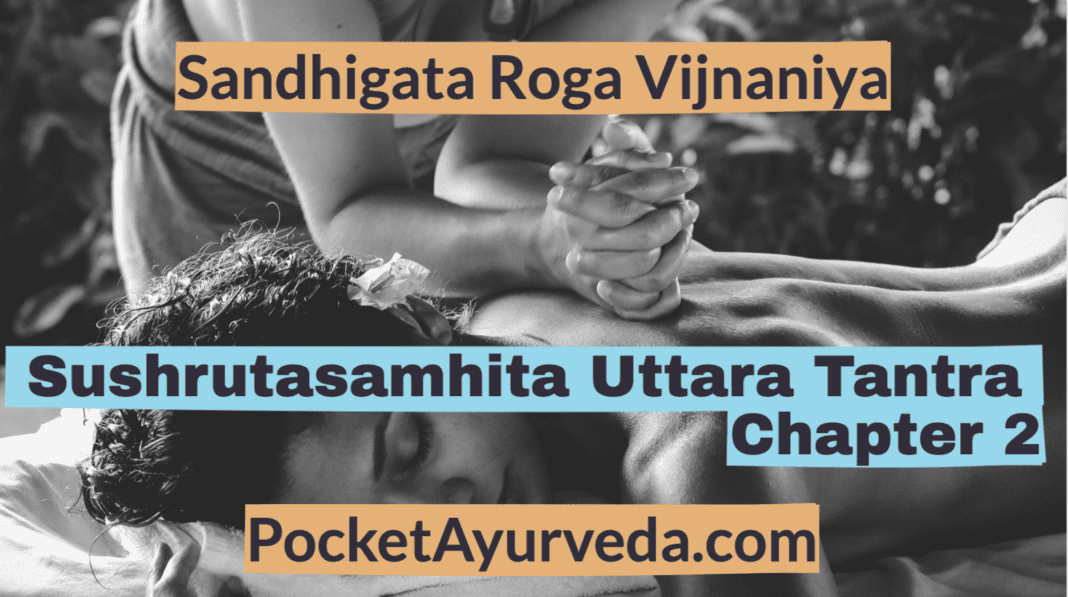द्वितीयोऽध्यायः अथातः सन्धिगतरोगविज्ञानीयमध्यायं व्याख्यास्यामः, धन्वन्तरिः॥१॥ यथोवाच भगवान्
Now we shall discourse on the chapter which deals with the pathology of diseases which are peculiar to the joints or binding membranes of the eye (Sandhigata-Roga-Vijnaniya). 1
पूयालस: सोपनाहः स्त्रावाः पर्वणिकाउलजी। क्रिमिग्रन्थिश्च विज्ञेया रोगाः सन्धिगता नव ॥ २ ॥
The names of those diseases-Diseases peculiar to the joining (Sandhi) of the eye are nine in number and are named puyalasa, Upanaha, (The four kinds of) Srava (Viz. Puya-srava, Slesma-srava, Raktasrava, Pitta-srava), Parvani, Alaji and Krimi-granthi. 2
Symptoms of Puyalasa and Upanaha
पक्वंः शोफः सन्धिजः संत्रवेद्यः सान्द्रं पूयं पूतिपूयालसः सः । ग्रन्थिर्नाल्पो दृष्टिसन्धावपाकः कण्डूप्रायो नीरुजस्तूपनाहः ॥ ३ ॥
Symptoms of Puyalasa and Upanaha- A suppurated swelling occurring at any of these joining and exuding a sort of fetid and dense¹ pus is called Puyalasa. A painless cyst (Granthi) of considerable size occurring at the union of the pupil (with the Krsna-mandala) and attended with an itching sensation and a little suppuration is called Upanaha. 3.
गत्वा सन्धीनश्रुमार्गेण दोषाः कुर्युः स्त्रावान् रुग्विहीनान् कनीनात् । तान् वै स्रावान् नेत्रनाडीमथैके तस्या लिङ्गं कीर्तयिष्ये चतुर्धा ॥ ४ ॥
1. According to madhava’s reading, the swelling should be painful (सतीद:), There is no mention whether the pus should be dense (H) or otherwise.
Symptoms of Srava
पाकः सन्धौ संत्रवेद्यश्च पूयं पूयास्त्रावो नैकरूपः प्रदिष्टः । श्वेतं सान्द्रं पिच्छिलं संस्त्रवेद्यः श्लेष्मास्त्रावो नीरुजः स प्रदिष्टः ॥ ५ ॥ रक्तास्त्राव: शोणितोत्थः सरक्तं कोष्णं नाल्पं संस्त्रवेन्नातिसान्द्रम् । पीताभासं नीलमुष्ण जलाभं पित्तास्त्रावः संत्रवेत् सन्धिमध्यात् ॥ ६ ॥
Symptoms of Srava – The (deranged) Dosas’ of the locality passing through the lachrymal ducts into the binding tissues of the four different Sandhis (joinings) set up a painless 2 secretion (Srava) from the localities characterised by the specific symptoms of the different Dosas involved. These are known as Sravas, Which according to some, are also called Netra-nadi and are classified into four different groups, the different symptoms of which will be described presently. A suppuration (D.r. Swelling) in any of the unions (Sandhi) of the eye marked by a discharge of pus is called puya-srava. This is due to the concerted action of the Dosas ( kapha, pitta and blood). The secretion of slimy, white and thick muco-purulent discharges marked by the absence of pain’ is called Slesma-srava. The flow of thin, warm and blood-streaked copious discharge due to a contaminated state of local blood is called Rakta-srava. A warm, water-like and yellowish blue ( D. R. reddish yellow) discharge from the middle part of the union (owing to the deranged condition of the Pitta ) is called Pitta-srava. 4-6.
Symptoms of Parvani
ताम्रातन्वी दाहशूलोपपन्ना रक्ताज् ज्ञेया पर्वणी वृत्तशोफा | । जाता सन्धौ कृष्णशुक्लेऽलजी स्यात् तस्मिन्नेवाख्यापिता पूर्वलिङ्गैः ॥ ७॥ क्रिमिग्रन्थिवर्त्मनः पक्ष्मणश्च कण्डूं कुर्युर्जन्तवः सन्धिजाताः । नानारूपा वर्त्मशुक्लस्य सन्धौ चरन्तोऽन्तर्नयनं दूषयन्ति ॥ ८ ॥
Symptoms of Parvani, etc. – A small, round and copper-coloured swelling occurring at the joining of the Krsna-mandala and sukla-mandla, due to the vitiated state of the local blood and attended with a burning sensation and aching pain, is called parvani. A swelling possessed of the preceding features and occurring at the very same joining is called Alaji (keratitis)’. A cyst of swelling (Granthi) characterised by an itching sensation appearing on the joining of the eye-lids and eye-lashes owing to the germination of parasites (Krimi) in those localities, is called Krimi-granthi. Parasites of different forms in such a case are found to infest the regions where the inner lining of the Vartma-mandala (eye-lid) is connected with the Sukla-mandala (Sclerotic coat) of the eye and to invade and vitiate the substance of the eye-ball. 7-8
1. The term “Dosa” here means Slesma, pitta, Rakta (blood) and the concerted action of the above three Dosas. It should be noted that the Vayu is excluded from the list as it does not produce any secretion.
2. Madhava does not mention this (painlessness ) to be a symptom.
3. According to Madhava’s reading, the absence of pain is not a necessary concomi
nant in this case.
4. According to Madhava’s reading thinness and warmnes are not essential.
इति सुश्रुत संहितायां उत्तरतन्त्रे सन्धिगतरोगविज्ञानीयोनाम fantaisearer: 11 2 II
Thus ends the second chapter of the Uttara-Tantra in the Susruta Samhita which deals with the pathology of the diseases peculiar to the Sundhi (unions) of the eye.




